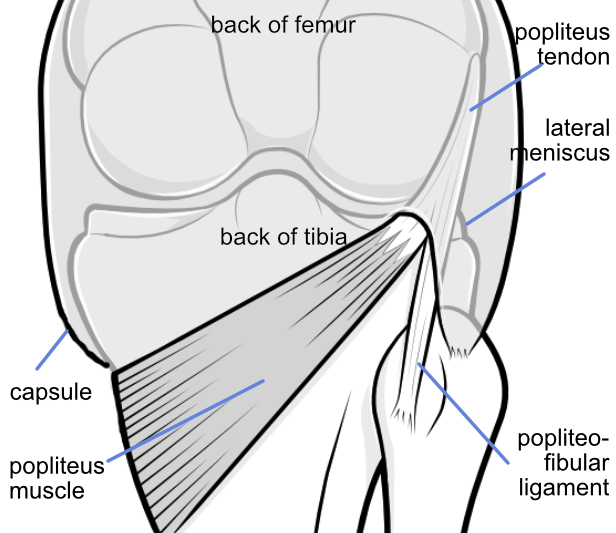A posterolateral corner injury includes damage to structures at the back of the knee on the outer side.
 Page updated February 2024 by Dr Sheila Strover (Clinical Editor)
Page updated February 2024 by Dr Sheila Strover (Clinical Editor)

This illustration of the posterolateral corner gives an idea that this region has a complicated anatomy.
How does one injure the posterolateral corner?
The posterolateral corner is most commonly injured in an accident involving a blow to the opposite side of the knee, that is to the front of the knee on the medial side. It can also be damaged by hyperextension or by the knee being forced into varus (ie. bowed outwards).
-
Quote from peer-reviewed papers:
"....Injuries to the posterolateral corner (PLC)....are most commonly associated with athletic trauma, motor vehicle accidents, and falls...."
Citation: Welsh P, DeGraauw C, Whitty D. Delayed diagnosis of an isolated posterolateral corner injury: a case report. J Can Chiropr Assoc. 2016 Dec;60(4):299-304. PMID: 28065990; PMCID: PMC5178015.
What are the signs and symptoms of posterolateral corner damage?
Symptoms of posterolateral corner disruption may be vague and confusing.
There may be bruising initially in the posterolateral area, and outward bowing when the person takes weight on that side. There are general feelings that the knee cannot be trusted. Stairs may be a particular problem. Feelings of instability and 'giving way' may be experienced. Damage to the fibular nerve may cause numbness or tingling of the foot and a foot drop and 'slapping' gait.
-
Quotes from peer-reviewed paper:
"....there is commonly a diffuse tenderness over the posterolateral knee and the fibular head due to irritation of the PLC structures, knee capsule, and common fibular nerve...."
-
"....an abnormal gait pattern may develop which the patient cannot compensate for. During the initial contact and loading phase of gait, the knee may suddenly angulate in a varus direction (known as a varus thrust gait)...."
Citation: Welsh P, DeGraauw C, Whitty D. Delayed diagnosis of an isolated posterolateral corner injury: a case report. J Can Chiropr Assoc. 2016 Dec;60(4):299-304. PMID: 28065990; PMCID: PMC5178015.
What posterolateral corner structures are most commonly injured?
Structures in the PLC may be damaged individually or several structures may be damaged at once.
Quote from peer-reviewed paper:
-
"....Three primary static stabilizing structures form the PLC: the fibular (or lateral) collateral ligament, the popliteus tendon, and the popliteofibular ligament...."
Citation: Figueroa F, Figueroa D, Putnis S, Guiloff R, Caro P, Espregueira-Mendes J. Posterolateral corner knee injuries: a narrative review. EFORT Open Rev. 2021 Aug 10;6(8):676-685. doi: 10.1302/2058-5241.6.200096. PMID: 34532075; PMCID: PMC8419800.
Why is the posterolateral corner an issue with ACL reconstruction?
An ACL reconstruction is highly likely to fail if the surgeon has not addressed PLC laxity due to damage to the structures there.
Quotes from peer-reviewed papers:
-
Diagnosis "....entails a detailed understanding about the posterolateral structures and function. A high level of suspicion is recommended based on the trauma setting and the patient symptoms. Failure to address this condition may place other reconstruction graft at risk...."
Citation: Chahla J, Moatshe G, Dean CS, LaPrade RF. Posterolateral Corner of the Knee: Current Concepts. Arch Bone Jt Surg. 2016 Apr;4(2):97-103. PMID: 27200384; PMCID: PMC4852053.
-
"....finding the balance between re-creating native anatomy and safely performing PLC reconstruction provides a big challenge...."
Citation: Figueroa F, Figueroa D, Putnis S, Guiloff R, Caro P, Espregueira-Mendes J. Posterolateral corner knee injuries: a narrative review. EFORT Open Rev. 2021 Aug 10;6(8):676-685. doi: 10.1302/2058-5241.6.200096. PMID: 34532075; PMCID: PMC8419800.
Forum discussions
- opinion needed re 13 year old daughter's knee
A mother struggles to identify the problem in her daughter's knee.
- Injury to anterior cruciate – post lateral corner - HELP!
Several patients discuss their experience with pposterolateral corner injury.
Relevant material -
 Course - 2009 - Posterolateral corner injuries of the knee - by Dr Frank R Noyes (Knee Surgeon)
Course - 2009 - Posterolateral corner injuries of the knee - by Dr Frank R Noyes (Knee Surgeon)